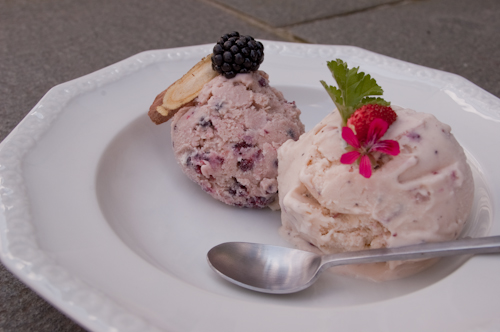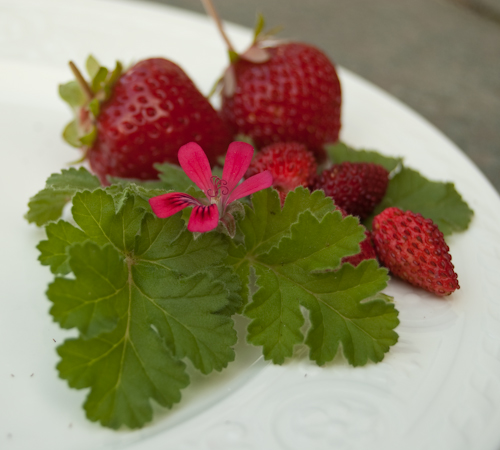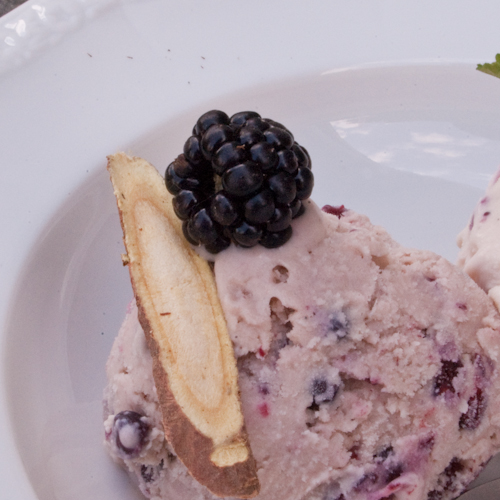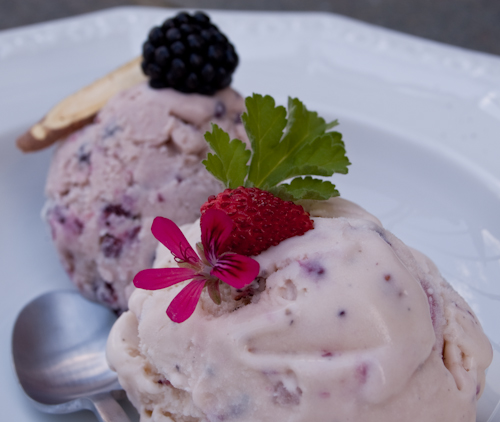Our weedy little berry bushes keep producing, and this time I include a couple of recipes for the berries I featured in my last post on food from the garden.
I’ve had a compressor ice cream maker languishing on my wish list for years now. Most of the models I’ve seen were so expensive (and our bottoms big enough already) that we couldn’t really justify the purchase, no matter how we tried. But when one model went on sale at the local warehouse club at a price less than half of the cheapest price we had seen until then, we just couldn’t help ourselves. What’s wrong with a round bottom?
I’ve made about 6 batches of ice cream with the machine, and the results have so far been excellent – creamy smooth, with no crunchy or buttery bits. This is much much better than what came from my previous machine. My old machine (which goes to the first commenter who wants to pick it up or pay for shipping) consists of a double-walled bowl filled with saline and a motorized mixing arm. You stick the bowl in the freezer, then take it out, put your ice cream base in, and start it mixing. Unfortunately, this results in a less than optimal temperature curve, too cold at the beginning, not cold enough at the end of the process. But it does still work, and we did have some reasonable batches out of it.
The new machine has inspired me to try a whole bunch of different flavors. Here are two that use the berries. The Bramble frozen yogurt turned out pretty well as far as the flavoring goes, but I admit the recipe still needs some tweaking. I’d consider going with a purer frozen yogurt recipe by dropping the eggs. The wild strawberry, on the other hand, is wonderful, and if you have the ingredients, you really should try it.

Two berry ice creams: Bramble-licorice frozen yogurt and Fraises-des-bois and Black Pepper-Rose Geranium ice cream
Bramble-licorice frozen yogurt
I know a lot of people hate licorice – or think they hate licorice. In the right contexts, I think pretty much anything can be tasty, and licorice is no exception. Brambles have a base scent that’s thick and rich and inky and tannic and, to me, the very smell of black. It’s also easily lost by over-processing or drowned out by more assertive aromas. A gentle application of licorice seems to highlight this illusive base scent. You might not even notice the licorice if you don’t know it’s there, though you would surely miss it in its absence.
Ingredients
Approximately 1 cup brambles or wild blackberries.
3 tbs creme de mure (blackberry liqueur) or creme de cassis
1/2 tsp natural licorice extract
1 cup sugar
2 cups cream
1/2 a split vanilla bean
2 pieces dried licorice root
3 eggs
1 cup whole milk yogurt
Method
- Combine the brambles, liqueur, and licorice extract, and set aside.
- Combine the cream, sugar, vanilla, and licorice root in a sauce pan. Heat until just boiling, then reduce to the barest of simmers. Allow to infuse for at least 10 minutes.
- In a separate bowl, beat the eggs together into one soupy mass.
- Fish the root and vanilla out of the cream. Whisk about half of the hot cream into the eggs, pouring slowly, in order to temper them. Then return the eggy cream to the rest in the saucepan.
- Gently heat the cream over medium heat, stirring with a silicon spatula or wooden spoon, until the mixture thickens slightly. It will cling to the stirring device slightly, and will have the consistency of melted ice cream (surprise!). Keep in mind that this point will occur at approximately 70°C to 75°C (about 160°F), so you shouldn’t even be in the same county as a boil. Or just use a thermometer and stop guessing.
- Strain the mixture into a bowl, and chill in the refrigerator overnight.
- Freeze in an ice cream machine. Add the reserved brambles during the final minutes of freezing.
Fraise-de-bois and Black Pepper-Rose Germanium Ice Cream
In the spring I purchased what was labelled as a rose-scented geranium (pelargonium) because I was keen to have the rose scent for baking. The variety, “England’s Rose”, didn’t have the pronounced rose scent I was looking for, but it smelled nice anyway – like the floral notes of very high quality black pepper without the bite. As the season wore on, a bit of rose scent did eventually appear. Brushing past this plant while carrying a bowl of wild strawberries inspired this flavor. If you don’t have a geranium, try black pepper and a few old-fashioned rose petals, or even some rose water. The flavor of the ice cream starts out with the rich floral berry tones of the strawberries, then after the cream warms on your tongue, the rose and pepper come out to play.

Rose-scented geranium leaves and a couple of fraises-des-bois. The garden strawberries are for comparison.
Ingredients
1/2 cup fraises-des-bois (more if you have them), cut into small bits if large
2 cups cream
1 cup milk
1 cup sugar
6 rose-scented pelargonium leaves, bruised up a bit
1/4 split vanilla bean
3 eggs
1 half turn of freshly ground pepper
Method
- Combine the cream, milk, sugar, geranium leaves, and vanilla. Infuse as in the previous recipe. Keep in mind that you’ll more likely smell the geranium on your tongue rather than smell it from the pot.
- Fish the leaves and vanilla out of the cream. Temper the eggs as in the previous recipe.
- Heat the eggy cream as above. Strain into a bowl.
- Add the fraises-des-bois and fresh pepper. Chill overnight.
- Freeze.
© 2011 – 2012, Converting a Church. All rights reserved.



4 comments
ed says:
August 12, 2011 at 21:11 (UTC 1 )
Great pictures. I have to find out where you can buy dried licorice root.
TheHighPriestess says:
August 13, 2011 at 11:04 (UTC 1 )
Thanks! Asian stores seem to be a pretty reliable source for dried licorice.
Tiffany @ No Ordinary Homestead says:
August 16, 2011 at 06:59 (UTC 1 )
I had no idea geranium was edible– nor have I ever heard of dried licorice. But both of these ice creams sound (and look) quite tasty!
TheHighPriestess says:
August 16, 2011 at 07:28 (UTC 1 )
Thanks!
I feel I should be super clear here, the non-citrus scented pelargoniums (“scented geraniums”) are edible, especially cultivars of pelargonium gravolens. The geraniums so beloved of windowboxes here in Germany are a completely different genus, and though they look awfully similar, are not edible.
The licorice root is the natural source material for the flavoring people put in candies and drinks and things. People in China sometimes flavor broth using the dried root.
Thanks for the comment!